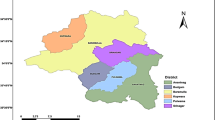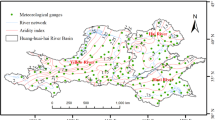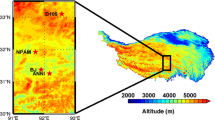Abstract
Evapotranspiration is one of the key components of hydrological processes. Assessing the impact of climate factors on evapotranspiration is helpful in understanding the impact of climate change on hydrological processes. In this paper, based on the daily meteorological data from 1960 to 2007 within and around the Aksu River Basin, reference evapotranspiration (RET) was estimated with the FAO Penman-Monteith method. The temporal and spatial variations of RET were analyzed by using ARCGIS and Mann-Kendall method. Multiple Regression Analysis was employed to attribute the effects of the variations of air temperature, solar radiation, relative humidity, vapour pressure and wind speed on RET. The results showed that average annual RET in the eastern plain area of the Aksu River Basin was about 1100 mm, which was nearly twice as much as that in the western mountainous area. The trend of annual RET had significant spatial variability. Annual RET was reduced significantly in the southeastern oasis area and southwestern plain area and increased slightly in the mountain areas. The amplitude of the change of RET reached the highest in summer, contributing most of the annual change of RET. Except in some high elevation areas where relative humidity predominated the change of the RET, the variations of wind velocity predominated the changes of RET almost throughout the basin. Taking Kuqa and Ulugqat stations as an example, the variations of wind velocity accounted for more than 50% of the changes of RET.
Similar content being viewed by others
References
Allen R G, Pereira L S, Raes D et al., 1998. Crop evapotranspiration: Guidelines for computing crop water requirements. FAO Irrigation and Drainage Paper 56, Food and Agriculture Organization of the United Nations, Rome.
An Yuegai, Li Yuanhua, 2005. Change of evaporation in recent 50 years in Hebei Region. Journal of Arid Land Resources and Environment, 19(4): 159–162. (in Chinese)
Chaouche K, Neppel L, Dieulin C et al., 2010. Analyses of precipitation, temperature and evapotranspiration in a French Mediterranean region in the context of climate change. Comptes Rendus Geoscience, 342: 234–243.
Chattopadhyay N, Hulme M, 1997. Evaporation and potential evapotranspiration in India under conditions of recent and future climate change. Agricultural and Forest Meteorology, 87: 55–73.
Chen Ying, Deng Ziwang, Shi Hongzheng, 2006, Temporal change of annual runoff volume of the Aksu River, a source stream of the Tarim River. Arid Zone Research, 23(1): 21–25. (in Chinese)
Cohen S, Ianetz A, Stanhill G, 2002. Evaporative climate changes at BetDagan, Israel, 1964 to 1998. Agricultural and Forest Meteorology, 111: 83–91.
Duan Yonghong, Tao Shu, Li Bengang, 2004. Spatial and temporal variation of reference crop evapotranspiration in Beijing. Chinese Agricultural Meteorology, 25(2): 22–25. (in Chinese)
Gao Ge, Chen Deliang, Ren Guoyu et al., 2006. Trend of potential evapotranspiration over China during 1956 to 2000. Geographical Research, 25(3): 378–387. (in Chinese)
Guo Hua, Xu Ming, Hu Qi, 2010. Changes in near-surface wind speed in China: 1969–2005. International Journal of Climatology, doi: 10.1002/joc.2091.
Han Songjun, Hu Heping, Yang Dawen et al., 2009. Differences in changes of potential evaporation in the mountainous and oasis regions of the Tarim Basin, Northwest China. Science in China (Series E), 52(7): 1981–1989.
Hulme M, Zhao Z C, Jiang T, 1994. Recent and future climate change in East Asia. International Journal of Climatology, 14: 637–658.
Intergovernmental Panel on Climate Change, 2007. Climate change 2007: The physical science basis. Contribution of Working Group I to the Fourth Assessment Report. In: Solomon S, D.Q, Manning M et al. Cambridge, UK: Cambridge University, 996.
Jiang Yan, Zhou Chenghu, Cheng Weiming, 2005. Analysis on runoff supply and variation characteristics of Aksu drainage basin. Journal of Natural Resources, 20(1): 27–34. (in Chinese)
Jiang Ying, Luo Yong, Zhao Zongci et al., 2010. Changes in wind speed over China during 1956–2004. Theoretical and Applied Climatology, 99: 421–430.
Kingston D G, Todd M C, Taylor R G et al., 2009. Uncertainty in the estimation of potential evapotranspiration under climate change. Geophysical Research Letters, 36, L20403, doi: 10.1029/2009GL040267.
Kundzewicz Z W, Somlyody L, 1997. Climatic change impact on water resources in a systems perspective. Water Resources Management, 11: 407–435.
Li Hongjun, Jiang Zhihong, Yang Qing, 2009. Association of North Atlantic Oscillations with Aksu River runoff in China. Journal of Geographical Sciences, 19(1): 12–24.
Liu Suxia, Mo Xingguo, Zhao Weimin et al., 2009a. Temporal variation of soil moisture over the Wuding River Basin assessed with an eco-hydrological model, in-situ observations and remote sensing. Hydrology and Earth System Sciences, 13: 1375–1398.
Liu Suxia, Qiu Jianxiu, Mo Xingguo, 2009b. Wind velocity variation from 1951 to 2006 in the North China Plain. Resources Science, 31(9): 1486–1492. (in Chinese)
Liu Xinchun, Yang Qing, Liang Yun, 2006. Study on the change of runoff and the effect factors in the Aksu River Basin in recent 40 years. China Population, Resources and Environment, 16(3): 82–87. (in Chinese)
Liu Yuan, Wang Ying, Yang Xiaoguang, 2010. Trends in reference crop evapotranspiration and possible climatic factors in the North China Plain. Acta Ecologica Sinica, 30(4): 923–932. (in Chinese)
Lu J B, Sun G, McNulty S G et al., 2005. A comparison of six potential evapotranspiration methods for regional use in the southeastern United States. Journal of American Water Resources Association, 41: 621–633, doi:10.1111/j.1752-1688.2005.tb03759.x.
McKenney M S, and Rosenberg N J, 1993. Sensitivity of some potential evapotranspiration estimation methods to climate change. Agricultural and Forest Meteorology, 64: 81–110.
Ouyang Rulin, Cheng Weiming, Wang Weisheng et al., 2007. Research on runoff forecast approaches to the Aksu River basin. Science in China (Series D), 50(suppl.): 16–25.
Peterson T C, Golubev V S, Groisman P Y, 1995. Evaporation losing its strength. Nature, 377: 687–688.
Ren Guoyu, Guo Jun, Xu Mingzhi et al., 2005. Climate changes of China’s mainland over the past half century. Acta Meteorological Sinica, 63(6): 942–956. (in Chinese)
Roderick M L, Farquhar G D, 2002. The cause of decreased pan evaporation over the past 50 years. Science, 298: 1410–1411.
Roderick M L, Farquhar G D, 2004. Changes in Australian pan evaporation from 1970 to 2002. International Journal of Climatology, 24: 1077–1090.
Shen Yongping, Wang Guoya, Zhang Jiangang, 2008. Human activity impacts on local climate and water environments of the Aksu River oasis, South Xinjiang. Arid Land Geography, 31(4): 524–534. (in Chinese)
Sun Xiaozhou, Feng Zhiming, Yang Yanzhao, 2009. Change tendency of reference crop evapotranspiration in Xiliaohe Basin. Resources Science, 2009, 31(3): 479–484. (in Chinese)
Vorosmarty C J, Federer C A, Schloss A L, 1998. Potential evaporation functions compared on US watersheds: Possible implications for global scale water balance and terrestrial ecosystem modeling. Journal of Hydrology, 207(3/4): 147–169.
Wang Youqi, Fan Jun, Shao Mingan et al., 2008. Analysis of effects of climate change on reference evapotranspiration on the Loess Plateau in recent 50 years. Transactions of the CSAE, 24(9): 6–10. (in Chinese)
Wu Sufen, Han Ping, Li Yan et al., 2003. Predicted variation tendency of the water resources in the headwaters of the Tarim River. Journal of Glaciology & Geocryology, 25(6): 708–711. (in Chinese)
Xie Xianqun, Wang Ling, 2007. Changes of potential evaporation in northern China over the past 50 years. Journal of Natural Resources, 22(5): 683–691. (in Chinese)
Yang Qing, Sun Churong, Shi Yuguang et al., 2006. Estimation of areal precipitation series and its relation to runoff in Aksu River Basin. Acta Geographica Sinica, 61(7): 697–704. (in Chinese)
Zhang Aiying, Ren Guoyu, Guo Jun et al., 2009a. Change trend analyses on upper-air wind speed over China in past 30 years. Plateau Meteorology, 28(3): 680–687. (in Chinese)
Zhang Fangmin, Shen Shuanghe, 2007. Spatial distribution and temporal trend of reference crop evapotranspiration in China. Journal of Nanjing Institute of Meteorology, 30(5): 705–709. (in Chinese)
Zhang Guangxing, 2007. The response of annual runoff to the height change at the zero temperature level in summer over Xinjiang. Acta Geographica Sinica, 62(3): 279–290. (in Chinese)
Zhang Xueqin, Ren Yu, Yin Zhiyong et al., 2009b. Spatial and temporal variation patterns of reference evapotranspiration across the Qinghai-Tibetan Plateau during 1971–2004. Journal of Geophysical Research, 114: D15105, doi:10.1029/2009JD011753.
Author information
Authors and Affiliations
Corresponding author
Additional information
Foundation: National Key Basic Research Development Program of China, No.2009CB421307; No.2010CB428404; National Natural Science Foundation of China, No.41071024
Rights and permissions
About this article
Cite this article
Zhang, S., Liu, S., Mo, X. et al. Assessing the impact of climate change on potential evapotranspiration in Aksu River Basin. J. Geogr. Sci. 21, 609–620 (2011). https://doi.org/10.1007/s11442-011-0867-0
Received:
Published:
Issue Date:
DOI: https://doi.org/10.1007/s11442-011-0867-0




